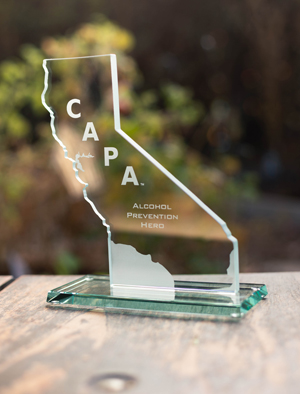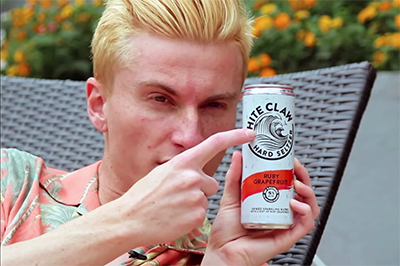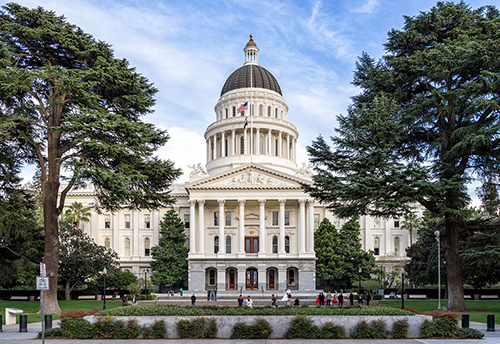Blog
2019 CAPA Summit Wrapup: From Local Power to Statewide Clout
 On Thursday, November 7, the approximately 150 attendees of the 4th Annual California Alcohol Policy Alliance (CAPA) Summit were confronted with two stark facts: advocates for a healthier California face daunting challenges, and in the face of those challenges, they can achieve remarkable victories. The Summit marked the end of a long and difficult legislative session, highlighted State Sen. Scott Wiener's seemingly unstoppable bill to extend bar closing hours suddenly killed on the assembly floor, in no small part due to local pressure applied by the coordinated efforts of CAPA. Membership celebrated that victory, but with that celebration came the realization that there were many more fights ahead.
On Thursday, November 7, the approximately 150 attendees of the 4th Annual California Alcohol Policy Alliance (CAPA) Summit were confronted with two stark facts: advocates for a healthier California face daunting challenges, and in the face of those challenges, they can achieve remarkable victories. The Summit marked the end of a long and difficult legislative session, highlighted State Sen. Scott Wiener's seemingly unstoppable bill to extend bar closing hours suddenly killed on the assembly floor, in no small part due to local pressure applied by the coordinated efforts of CAPA. Membership celebrated that victory, but with that celebration came the realization that there were many more fights ahead.In recognition of the emerging power of a united CAPA voice, the Summit theme was "Building a Movement." The event opened with a recognition of individuals who were integral to that building effort. First, CAPA issued an award to Los Angeles City Council Member Paul Koretz, his Communication Director Alison Simard, and his Director of Policy and Legislation Jeffrey Ebenstein. Councilmember Koretz was an early and vocal opponent of extended last calls, even as Los Angeles Mayor Eric Garcetti endorsed the bill. With Koretz and his staff's willingness to stand up against the blatant harms threatened by the bill, backed by the voices of Los Angeles residents and the members of CAPA, the Los Angeles city council issued a resolution condemning the bill, leading to its defeat on the California State Assembly floor.
CAPA was also proud to commemorate the vital public health and safety contributions from California Assembly Member Tom Lackey; Los Angeles City Council Member Paul Krekorian; Community Promotora Mirian Castro, and CAPA Co-Chair Richard Zaldivar.
 The awards took the form of Wakinyan Thunder necklaces, handmade and individualized pieces by Oglala Lakota artists and activists Kathryn Thunder Hawk and Robert Swimmer. "The necklaces were made with good energy, with good thoughts, and blessings," presenter Veronica de Lara, CAPA co-chair, explained. "Each piece is meaningful in Lakota culture and they provide strength and fortitute to those in a path of service to all."
The awards took the form of Wakinyan Thunder necklaces, handmade and individualized pieces by Oglala Lakota artists and activists Kathryn Thunder Hawk and Robert Swimmer. "The necklaces were made with good energy, with good thoughts, and blessings," presenter Veronica de Lara, CAPA co-chair, explained. "Each piece is meaningful in Lakota culture and they provide strength and fortitute to those in a path of service to all."Between rounds of awards, attendees broke out into special topic sessions, including:
- Social Justice Movements
- Community Engagement
- Authentically Integrating Voices of the LGBTQ+ Community
- Proactive Legislation
"I'm proud of what CAPA accomplished this year," said Mayra Jiménez, Advocacy Manager for CAPA. "But alcohol is not a simple problem. It attacks the most vulnerable, and the industry is so committed to hiding the harm. We need to make sure everybody's voice is heard loudly in this fight."
The session concluded with a special presentation from California Department of Alcoholic Beverage Control (ABC). The session was intended to both make the workings of ABC transparent and to provide a venue for dialogue between the community and the department. Following a presentation on ABC operations and pending legislation--including the implementation of AB 1221, which mandates responsible beverage service training for all California bars and restaurants--ABC Director Jacob Appelsmith stood for a lively Q&A session. Copies of the ABC presentation are available on the CAPA website.
The Summit closed with a reiteration of the goals and challenges facing CAPA and everyone working in the harm prevention space. Attendees were left to think about what they could accomplish in 2020. Hopefully, the answer was, in part, "More than we thought we could this morning."
WATCH Councilmember Krekorian's speech from the 2019 CAPA Summit.
New Hard Seltzer and the Big Old Lie
 No beverage product has received more publicity over the past year than hard seltzers. These colorless carbonated alcoholic drinks often come with the same faint fruit flavors of La Criox. Hard seltzer brands such as White Claw, Bon & Viv, and Truly advertise their low calories, lack of gluten, and inclusion of fruit. It's nice to think that consumers, jaded on the repeated, deceptive, manipulative, and sometimes overtly corrupt efforts to connect alcohol to health, are immune to the "healthy drinking" scam. But hard seltzers are one of the most rapidly growing product groups in the industry. According to Vox.com, their current market share is estimated at $550 million, and at least one forecaster has that growing to as much as $2.5 billion by 2021.
No beverage product has received more publicity over the past year than hard seltzers. These colorless carbonated alcoholic drinks often come with the same faint fruit flavors of La Criox. Hard seltzer brands such as White Claw, Bon & Viv, and Truly advertise their low calories, lack of gluten, and inclusion of fruit. It's nice to think that consumers, jaded on the repeated, deceptive, manipulative, and sometimes overtly corrupt efforts to connect alcohol to health, are immune to the "healthy drinking" scam. But hard seltzers are one of the most rapidly growing product groups in the industry. According to Vox.com, their current market share is estimated at $550 million, and at least one forecaster has that growing to as much as $2.5 billion by 2021.The rise of hard seltzers are the dark side of a hopeful trend: younger generations may be less likely to use alcohol than their forerunners. It is unclear whether this decline comes from the economic hardships Milennials and "Gen Z" face, from the rise of legal cannabis, from effective prevention campaigns, or from shifting trends. What is clear is that Big Alcohol is concerned, and hard seltzers are what they hope to be the magic bullet. Speaking the Brewbound (subscription required), Molson Coors confirmed that their new hard seltzer, Vizzy, is targeted directly at the 21 to 34-year-old market. Ultimately, hard seltzers are just another incarnation of flavored malt beverages--cheap, easy-to-drink alcohol that carries significant appeal to novice drinkers, especially those underage.
Needless to say, the marketing surrounding hard seltzer is an overt, if well-worn, lie. Alcohol use alone carries health risks. Even low levels of drinking can leave a consumer vulnerable to cancers and certain cardiovascular diseases. As consumption rises, organ damage, accidental injury, motor vehicle crashes, violence, and self-harm become significant risks as well. Alcohol dehydrates, may slow muscle recovery, and interferes with metabolism--never mind the hangover (and potential for long-term mental decline). This is part of why this same lie needs to be constantly repackaged for new generations.
As the old lies recur, so do the old bad actors. FourLoko, a manufacturer notorious for selling products in such large containers and at such high concentration that a single can becomes the equivalent of binge drinking, has introduced its own line of 12% ABV seltzers in 22 oz. cans. This is the equivalent of 5 White Claws, which, at 5%, are already towards the higher end of canned alcohols. Multiple bars, meanwhile, use the seltzers as a base to build mix drinks.
And with bad actors come bad laws. In 2019, Big Alcohol successfully conned the California legislature into placing its products in the same tax class as beer, which is already the least taxed of all alcoholic products. This comes despite the fact that their production often bears more in common with hard liquors than Bud Light (and at 12%, FourLoko's product is stronger than many wines).
"These companies are making potentially high-potency, nearly flavorless alcoholic beverages, and paying back peanuts," said Michael Scippa, Public Affairs Director for Alcohol Justice. "We need tax rates to reflect the real harm. When you get around 6 or 7%, you're already selling more than single serving of alcohol, especially in big cans. We need to get rid of this loophole and get a Charge for Harm tax system in place, starting today."
Already, backlash is in place. Writing for Eater.com, Jaya Saxena points out that "positioning alcohol as a tool to build a better, cleaner body is just the flip side of positioning it as a cool potion necessary for any adult party—either narrative makes it harder to have a healthy relationship with it." The alcohol harm prevention world needs to be taking a long, hard look at these products, and speaking loud against the healthy drinking myth. Fighting the hype is the only healthy choice.
READ MORE about the exploitive myths of healthy drinking.
READ MORE about the alcohol industry's efforts to corrupt NIAAA.
READ MORE about Charge for Harm in California.
GUEST VOICES: Time for Opioid Makers to Pay Their Share
by Ramon Castellblanch, Ph.D., President, Quality Healthcare Concepts, Inc.
With AB 1468 (McCarty), opioid manufacturers and distributors will begin to pay California to help stop the deaths and misery caused by the opioid epidemic, off of which these businesses have so highly profited. For two decades, opioid manufacturers and distributors have irresponsibly promoted opioids. Opioid-makers like the Sackler family-owned Purdue Pharma have pleaded guilty to misleading regulators, doctors and patients about their opioid Oxycontin’s risk of addiction and its potential to be abused. Opioid distributors like Cardinal Health and AmerisourceBergen have settled lawsuits that they were shipping opioids to “pill mill” pharmacies that dispense excessive numbers of painkillers.
CA Alcohol Legislation to Watch in 2019
 Lowlights include cutting alcohol taxes, continuing the campaign to strip protective last calls
Lowlights include cutting alcohol taxes, continuing the campaign to strip protective last calls
As California lawmakers go into a new legislative year, they bring with them some classically bad ideas. From lifting restrictions on alcohol sales to lowering taxes on youth-friendly beverages, the slate of bills is peppered with red flags. One promising bill, however, takes a novel approach to reducing driving under the influence (DUI).
AB 205, the “All Beer, All the Time” Bill: In a short-sighted giveaway to megabrewers, this bill would add new beverages to the beer category. Specifically, it eliminates the requirement that a beer be made of barley, malt, and hops, including alcoholic beverages made from fermented fruit, honey, and natural sugars. This distinction affect more than just the technical definition of beer. Beer enjoys lower tax rates and can be sold in more kinds of stores than other alcoholic beverages (specifically, wine and liquor). Already, Big Alcohol finds loopholes to get alcopops and similar fruit-flavored drinks fortified with distillled spirits sold as “beer”. This bill just makes it easier to inundate the state with this kind of kid-friendly, easy-to-drink faux Schlitz.
AB 475, the “Drunk Artist” Bill: Every year, the legislature tries to carve out a new, special venue where alcohol can be distributed. This year, “paint and sip” classes are the benefactor. This kind of “class” involves getting tipsy while learning or practicing painting. Already, venues licensed to serve alcohol offer this kind of recreation. AB 475 would create a new carveout so that anyone offering that kind of class could get a liquor license. Aside from increasing overconsumption and alcohol outlet overconcentration, it continues the Dry Bar Bill’s precedent wherein any economic activity can be used as an excuse for alcohol service. Ultimately, real lessons do not require drunk students.
SB 55, the “Guns and DUI” Bill: This innovative bill would revoke a gun owner’s permit for 10 years if they violate certain laws involving alcohol intoxication, including DUI. On a simple level, this provides a new enforcement mechanism to dissuade drivers from getting behind the wheel after drinking. On a more complicated level, this acknowledges the tragic role alcohol intoxication plays in encouraging firearms violence. This law would reduce both forms of alcohol-related harm—gun-related and dangerous-driving-related.
SB 58, the “Relentlessly Dangerous 4 A.M. Bar” Bill: As detailed elsewhere, 2018 marks the third consecutive year in which Sen. Scott Wiener has attempted to overturn California’s standardized last call time. In this case, the senator may be “governor shopping”. After all, erstwhile Gov. Jerry Brown was crucial in vetoing last year’s version of the bill, while Governor Gavin Newsom is, himself, a benefactor of the alcohol industry. This makes it imperative that concerned Californians stop the bill in the legislature. After all, later last call times are associated with more violence, injury, emergency room impact, crime and enforcement costs, and, of course, early-morning dangerous driving.
Alcohol Justice remains determined to fight alcohol deregulation and dangerous legislation. We will keep you updated as these bills move through the capitol, or you can follow them on our California Alcohol Legislation Tracker.
READ MORE about the Dry Bar Bill.
READ MORE about how alcohol may compromise the governor.
READ MORE about the dangers of late last call times.
More Articles ...
Help us hold Big Alcohol accountable for the harm its products cause.
| GET ACTION ALERTS AND eNEWS |
STAY CONNECTED    |
CONTACT US 24 Belvedere St. San Rafael, CA 94901 415-456-5692 |
SUPPORT US Terms of Service & Privacy Policy |


